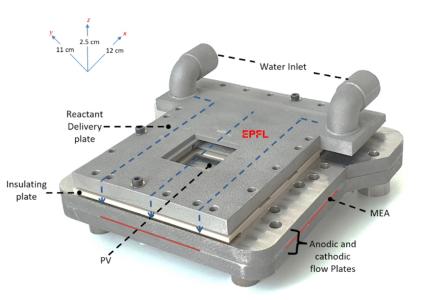Versatile Energy, Water, Hydrogen and Oxygen production and Storage System based on a reversible Photo-Electrochemical device
Programme
TDE
Programme Reference
T722-601MM
Prime Contractor
ALMATECH SA
Start Date
End Date
Status
Closed
Country
Switzerland

Objectives
To develop and assess a versatile energy, water, hydrogen and oxygen production and storage systems based on an integrated and reversible Photo-Electrochemical device (IPEC) for space applications
Description
The proposed system uses concentrated solar energy for the generation of H2, O2 (O2 interesting for Life Support, H2/O2 interesting for Propulsion), electricity and heat from water in forward operation mode (in-sun operations) and allows the production of water, electricity and heat in its backward operation mode (in-dark operations).
The Hydrogen and Oxygen generation is at high pressures (between 30 to 150 bar) facilitating its processing for storage (interesting pressure range for Power storage application). Efficient energy conversion, storage and management play a key role in resources utilization almost as vital is the management of water and Oxygen supplies for manned missions.
The environmental conditions on Lunar/Mars surface and its day/night cycle (with long periods of darkness) make the provision and management of energy a particularly critical challenge with respect to resource utilization. For a future permanent base on Moon or Mars or for space stations, self-sustainability capabilities will be required.
Thanks to its reversibility, this system can be used for the continuous generation of heat and electricity in a closed loop configuration i.e day/night operation modes are continuously alternated with the same water content alternately stored as water and/or H2 and O2.
In an open loop operation mode, this system can produce fuel (H2 O2) or breathable Oxygen from water supply. This mode is particularly adapted to In-Situ Resource Utilization (Moon/Mars) for habitation and transport.
The fully integrated IPEC system is compact, lightweight and highly efficient. It nevertheless requires highly concentrated solar radiations through the use of solar reflectors. These later can be designed as lightweight reflecting deployable structures.
The main tasks of this activity are :
- Basic system study and tests to understand the benefits and drawbacks for each of the targeted applications (e.g. Lifetime, conversion current per gram, roundtrip efficiency of total plant, reversibility...) Allowing comparison with other technologies (e.g. Vs. The Proton Exchange Membrane electrolysis system), including potential testing in specific use cases
- definition of a preliminary conceptual design
- identification of criticalities for the adaptation to Space of the system;
- Recommendations and roadmap for future development
Application Domain
Generic Technologies
Technology Domain
19 - Propulsion
22 - Environmental Control & Life Support (ECLS) and In Situ Resource Utilisation (ISRU)
3 - Space Systems Electrical Power
Competence Domain
6-Life & Physical Science Payloads, Life Support, Robotics & Automation
Initial TRL
TRL 1
Target TRL
TRL 2
Achieved TRL
TRL 2
Public Document
